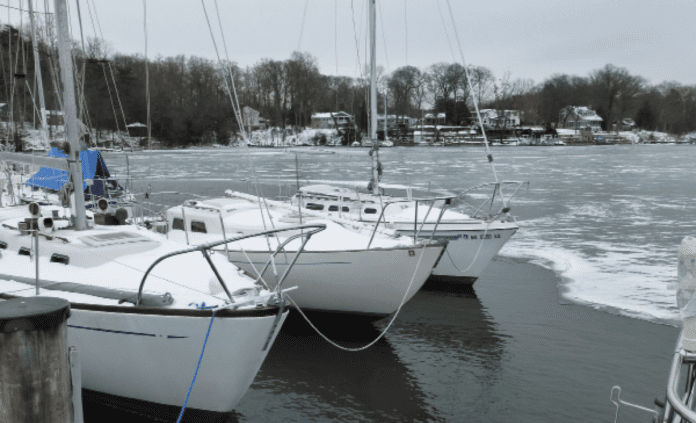Insurance and hurricane risk may require a layup. But I’ve been quite happy wintering in the mid-Chesapeake, snow, ice and all. Over 35 years, the only times my boat has been materially damaged were both on the hard, which colors my thinking.
In Deale, MD, there are only a few weeks each year where ice prohibits sailing. The Chesapeake varies, and even within Deale it depends. Some harbors have little tidal exchange and freeze faster. Some years are colder, and every 10 years or so enough ice comes down from the break-up on the Susquehanna to become a hazard to navigation for a week or two. But by and large, I sail every month, though I pick the nice days in January and February.
Many insurance policies require some manner of layup, but the “layup” can be nothing more than an in-water period of non-use. Presumably, during this period you will perform your annual inspections, but the details are seldom specified. Obviously, you need to set a day aside for spring “commissioning,” and check your hoses and rigging, change the oil, and do all of the things that constitute the normal launching checklist. Since the boat was never really out of service, some checklist items are unnecessary. Batteries will stay charged, sails and canvas stay in place, ventilation has been more consistant, and hopefully you have continued your normal walk-around inspections.
Freeze damage risk is different. In the mid-Chesapeake, the cabin will rarely go below freezing because the temperature is moderated by the water, which is just above freezing. Bilge pumps continue to operate reliably as long as there are no check valves or low spots in the plumbing, and the water can drain back into the bilge between cycles (the bilgewater is above freezing because the water is). Out of the water, the whole boat will see 15 F at least once and possibly see much lower temperatures. Saturated rudders can split. Bilges can be damaged.
TROUBLE SPOTS
Hull damage due to ice is rare, and is normally the result of the ice moving in strong currents or exposure to strong weather. Pressure from stationary ice will at worst lift the boat a little. Typically it does not freeze right up against the hull due the hull’s bobbing motion.
On the other hand, a failed hose or burst fitting can result in sinking. Winterizing must be meticulous, with glycol in every critical line, including pushing a little through the thru-hulls before closing them.
Hoses must be inspected and renewed as needed, and everything below the waterline must be double clamped. Twin bilge pumps are a good idea, and you must plan to visit the boat monthly. Docks can be slippery and falling in can be deadly.
In 35 years, only twice have I had material damage to a boat when it was not moving, and both times were on the hard. The stands were placed improperly, once pushing the hull inward, and the other cracking frame tabbing. Heavy snow was also a factor. In the water, snow load is gently distributed.
The sailing is the main motivator. I can’t leave the boat for 5 months, and the very best sailing is often early spring and late fall, when everyone else is struggling to get their boat in or out of the water. The wind is better, and the evenings are cool for sleeping, and waters are uncrowded.
There is there is also less bottom painting. Many paints lose their effectiveness after prolonged periods out of the water, requiring either a fresh sanding or a fresh coat A good multi-season paint will last me three years, eliminating hauling, washing, and painting costs.
Multi-season paints cost a bit more, and a second or third coat is required, but there are no seasonal storage fees. The savings are thousands each year, and about $60,000 over the time I’ve owned boats. And while you are scraping and sanding, or at least waiting for the travel lift schedule, I’m enjoying a lovely May sail.







































